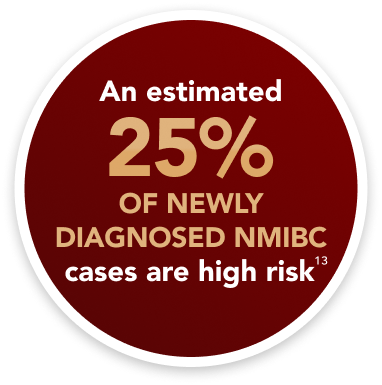Approximately 75% of bladder cancers are Non–Muscle Invasive Bladder Cancer (NMIBC)1
NMIBC frequently recurs and can progress to muscle invasive disease2-7


Overall in NMIBC:
NMIBC develops in the epithelium (mucosa) and advances to the subepithelial connective tissue (lamina propria)8-10
Reported 5-year recurrence and progression rates can vary depending on stage, grade, size, multiplicity, and treatment2-7
- ~20%-80% recurred within 5 years2-5
- ~10%-30% progressed within 5 years2-7
5-year overall survival was reported to be ~71% in patients with NMIBC based on analysis from the Surveillance, Epidemiology, and End Results (SEER) Program, 2004-201511
Risk Stratification of NMIBC Accounts for Tumor Size, Invasiveness, Grade, and Additional Factors12
Low Risk
- Papillary urothelial neoplasm of low malignant potential
- Low-grade solitary Ta ≤3 cm
Intermediate Risk
- Low-grade:
- Ta recurrence within 1 year
- Multifocal Ta
- Solitary Ta >3cm
- T1
- High-grade Ta ≤3 cm
High Risk
- High-grade:
- T1
- Any recurrent Ta
- Ta >3 cm or multifocal
- Any CIS
- Any BCG failure in high-grade patient
- Any variant histology
- Any lymphovascular invasion (LVI)
- Any high-grade prostatic urethral involvement


References:
Referenced with permission from the NCCN Clinical Practice Guidelines in Oncology (NCCN Guidelines®) for Bladder Cancer V7.2024. © National Comprehensive Cancer Network, Inc. 2025. All rights reserved. Accessed March 10, 2025. To view the most recent and complete version of the guideline, go online to NCCN.org.
Sylvester RJ, van der Meijden APM, Oosterlinck W, et al. Predicting recurrence and progression in individual patients with stage Ta T1 bladder cancer using EORTC risk tables: a combined analysis of 2596 patients from seven EORTC trials. Eur Urol 2006;49(3):466-477. doi:10.1016/j.eururo.2005.12.031
Fernandez-Gomez J, Madero R, Solsona E, et al. Predicting nonmuscle invasive bladder cancer recurrence and progression in patients treated with Bacillus Calmette-Guerin: the CUETO scoring model. J Urol. 2009;182(5):2195-2203. doi:10.1016/j.juro.2009.07.016
Cambier S, Sylvester RJ, Collette L, et al. EORTC nomograms and risk groups for predicting recurrence, progression, and disease-specific and overall survival in non–muscle-invasive stage Ta–T1 urothelial bladder cancer patients treated with 1–3 years of maintenance Bacillus Calmette-Guérin. Eur Urol 2016;69(1):60-69. doi:10.1016./j.eururo.2015.06.045
Martin-Doyle W, Leow JJ, Orsola A, Chang SL, Bellmunt J. Improving selection criteria for early cystectomy in high-grade T1 bladder cancer: a meta-analysis of 15,215 patients. J Clin Oncol. 2015;33(6):643-650. doi:10.1200/JCO.2014.57.6967
Kamat AM, Hahn NM, Efstathiou JA, et al. Bladder cancer. Lancet. 2016;388(10061):2796-2810. doi:10.1016/S0140-6736(16)30512-8
Gontero P, Sylvester R, Pisano F, et al. Prognostic factors and risk groups in T1G3 non–muscle-invasive bladder cancer patients initially treated with Bacillus Calmette-Guérin: results of a retrospective multicenter study of 2451 patients. Eur Urol 2015;67(1):74-82. doi:10.1016/j.eururo.2014.06.040
Kanmalar M, Abdul Sani SF, Kamri NINB, et al. Raman spectroscopy biochemical characterisation of bladder cancer cisplatin resistance regulated by FDFT1: a review. Cell Mol Biol Lett. 2022;27(1):9. doi:10.1186/s11658-022-00307-x
Saginala K, Barsouk A, Aluru JS, Rawla P, Padala SA, Barsouk A. Epidemiology of bladder cancer. Med Sci (Basel). 2020;8(1):15. doi:10.3390/medsci8010015
Batista R, Vinagre N, Meireles S, et al. Biomarkers for bladder cancer diagnosis and surveillance: a comprehensive review. Diagnostics (Basel). 2020;10(1):39. doi:10.3390/diagnostics10010039
Ślusarczyk A, Zapala P, Zapala L, Borkowski T, Radziszewski P. Cancer-specific survival of patients with non-muscle-invasive bladder cancer: a population-based analysis. Ann Surg Oncol. 2023;30:7892-7902. doi:10.1245/s10434-023-14051-9
Holzbeierlein JM, Bixler BR, Buckley DI, et al. Diagnosis and treatment of non-muscle invasive bladder cancer: AUA/SUO Guideline: 2024 amendment. J Urol. 2024;211(4):533-538. doi:10.1097/ju.0000000000003846
Bedke J, Black PC, Szabados B, et al. Optimizing outcomes for high-risk, non-muscle-invasive bladder cancer: the evolving role of PD-(L)1 inhibition. Urol Oncol. 2023;41(12):461-475. doi:10.1016/j.urolonc.2023.10.004
Tang DH, Chang SS. Management of carcinoma in situ of the bladder: best practice and recent developments. Ther Adv Urol. 2015;7(6):351-364. doi:10.1177/1756287215599694
NCCN makes no warranties of any kind whatsoever regarding their content, use or application and disclaims any responsibility for their application or use in any way.